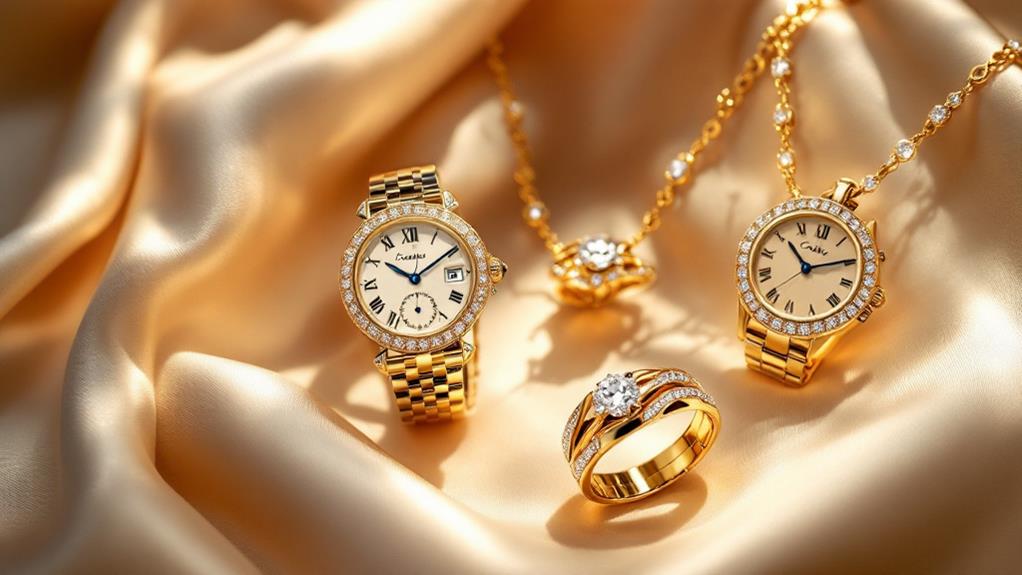The Fascinating History of Tiffany & Co
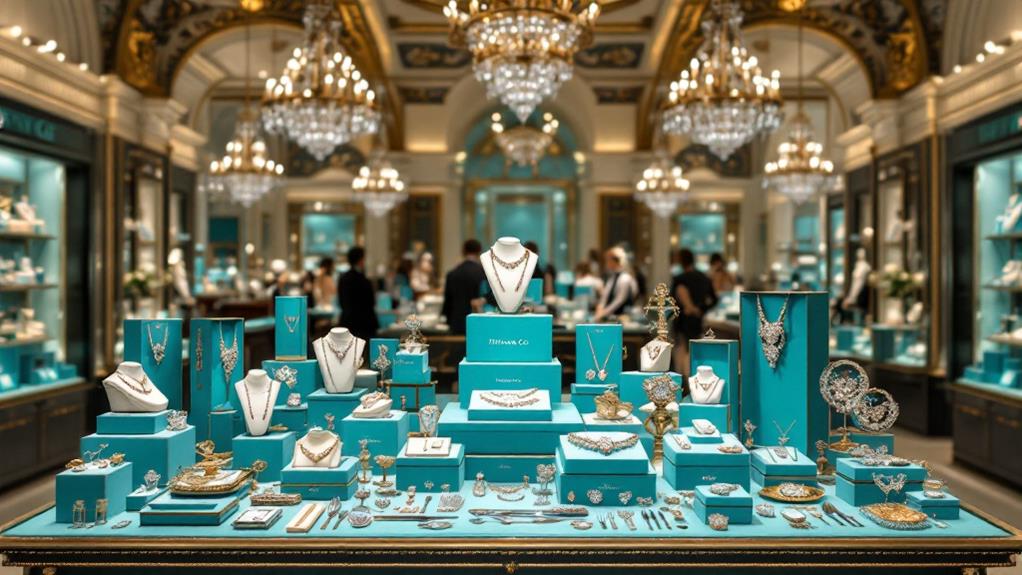
Tiffany & Co.'s story captivates you from its humble beginnings in 1837 New York with Charles Lewis Tiffany at the helm. Originally a luxury goods store, it quickly became synonymous with elegance thanks to iconic elements like the Tiffany Blue and the groundbreaking Tiffany Setting. Esteemed designers such as Elsa Peretti and Paloma Picasso further enhanced its jewelry to art. The brand's role in popular culture was cemented by "Breakfast at Tiffany's" and collaborations with celebrities. With a commitment to both luxury and social responsibility, Tiffany remains a lighthouse of sophistication and allure. This expedition offers much more to uncover.
Founding of Tiffany & Co
The legacy of Tiffany & Co. began with a modest investment and a vision for excellence. Founded on September 18, 1837, by Charles Lewis Tiffany and John B. Young, the store opened as Tiffany & Young in New York City. With $1,000 borrowed from Charles' father, they started as a fancy goods store, selling stationery and a range of luxury items. The initial day's sales were a humble $4.98, but it laid the groundwork for something extraordinary.
In 1845, Tiffany published the Blue Book Collection, the premier American direct mail catalog, showcasing an assortment of products and capturing the imagination of customers across the nation. This was an creative move that highlighted the company's forward-thinking approach.
The Iconic Tiffany Blue
Charles Lewis Tiffany's foresight didn't stop at groundbreaking selling techniques; it extended to the creation of a visual identity that would become iconic over time. In the 1840s, he introduced the unmistakable Tiffany Blue, a color now synonymous with the brand's identity and luxury offerings. This distinctive hue was officially trademarked as Tiffany Blue in 1998 and standardized as Pantone 1837 Blue, paying homage to the year Tiffany & Co. was founded.
The allure of Tiffany Blue extends beyond just a color—it's a symbol of elegance and sophistication recognized worldwide. You probably know it best from the Tiffany Blue Box, which debuted in the mid-19th century. This box isn't just packaging; it's a guiding light of excitement and anticipation, often linked to dreams and special moments. When you see that box, you know something extraordinary awaits inside.
Tiffany Blue's iconic status greatly anchors the brand identity of Tiffany & Co., capturing the imagination of customers globally. It's not just a color; it's a promise of luxury and a celebration of life's most memorable occasions, making you feel part of something timeless and exquisite.
The Tiffany Diamond
Step into the world of opulence with the Tiffany Diamond, a gem that not only dazzles with its brilliance but also tells a story of luxury and legacy. Acquired by Charles Lewis Tiffany in 1878 for $18,000, this extraordinary stone began its expedition as a 287.42-carat rough stone. With exceptional craftsmanship, it was transformed into a 128.54-carat fancy yellow diamond, becoming one of the largest and most stunning of its kind in the world. Its remarkable color and clarity set it apart, making it a symbol of the unparalleled elegance embodied by Tiffany & Co.
Over the years, the Tiffany Diamond has graced numerous settings, most prominently a breathtaking necklace in 2019 worn by Beyoncé during a Tiffany & Co. ad campaign. This iconic gem continues to capture the imagination of jewelry enthusiasts worldwide. As a cornerstone of Tiffany's heritage, it represents the brand's commitment to luxury and fine craftsmanship. Today, you can marvel at its beauty and history at Tiffany & Co.'s flagship store in New York City, where it remains a symbol of the brand's enduring allure and prestige in the world of fine jewelry.
Revolutionary Tiffany Setting
As you move from the legacy of the Tiffany Diamond, prepare to investigate another hallmark of Tiffany & Co.'s creativity with the groundbreaking Tiffany Setting. Introduced in 1886 by Charles Lewis Tiffany, this setting transformed the engagement ring market forever. Its six-prong design raises the diamond above the band, allowing maximum light exposure and brilliance. The Tiffany Setting highlights the diamond's beauty, making it appear to float, thereby enhancing its visual impact.
This inventive design quickly became the standard for modern diamond engagement rings, earning numerous awards at international exhibitions. By prioritizing craftsmanship and elegance, Tiffany & Co. set a new benchmark in the jewelry industry. The Tiffany Setting's timeless appeal continues to captivate, symbolizing not just a ring but an entire legacy of exquisite design.
As you stroll down Fifth Avenue, where Tiffany & Co.'s flagship store resides, imagine how this iconic setting has captured hearts worldwide. The Tiffany Setting remains one of the most popular styles for engagement rings, representing unparalleled sophistication and the enduring allure of a diamond. Its groundbreaking design has not only changed how engagement rings are crafted but also how they're cherished.
Renowned Designers' Contributions
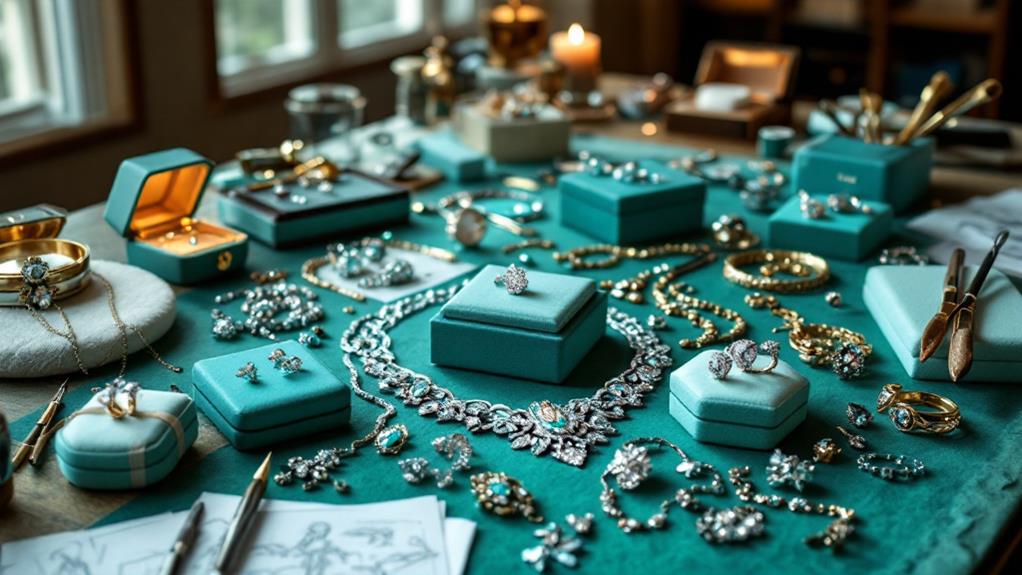
Tiffany & Co.'s legacy is not just about its iconic settings but also the visionary designers who've shaped its identity. Elsa Peretti, with her modern and organic designs, has left an indelible mark on Tiffany's aesthetic. Her Bone cuff and Open Heart collections are perfect examples of luxury jewelry that remains timeless and creative. You'll find her work effortlessly blending elegance with everyday wearability, making them highly sought after even today.
Jean Schlumberger brought a touch of whimsy to Tiffany in the 1950s. His nature-inspired pieces, like the Bird on a Rock and Tubereuse designs, have become synonymous with the brand's artistic spirit. He transformed ordinary materials into extraordinary works of art, cementing his place in Tiffany's rich legacy. His designs are not just jewelry; they're statements of imaginative artistry.
Paloma Picasso introduced a lively and sophisticated flair to Tiffany. Her use of color and bold designs, such as the Paloma's Graffiti line, reflect her unique artistic vision. This collection embodies both luxury and creativity, showcasing her connection to the brand and its reputation for elegance.
Together, these designers have raised Tiffany to a leader in creative and timeless jewelry design.
Tiffany's Philanthropic Efforts
With a commitment to environmental stewardship and social responsibility, Tiffany & Co. has made significant strides in philanthropy. Since 2000, the company's philanthropic efforts have included allocating about $20 million towards marine life and coral conservation initiatives. This reflects their dedication to sustainable practices, especially evident when Tiffany & Co. stopped selling coral jewelry in 2004 to protect ocean ecosystems.
You might find it impressive that Tiffany & Co. goes beyond coral conservation. Their Foundation plays an essential role in environmental rehabilitation by supporting the restoration of abandoned mines. This initiative targets lands devastated by unethical mining practices, underscoring Tiffany's commitment to ethical mining. By investing in projects that restore ecological balance, they show how luxury and responsibility can coexist.
Another significant endeavor is their support for the Peace Diamonds Restoration Initiative by Resolve. This project focuses on rehabilitating lands affected by unethical mining, demonstrating Tiffany & Co.'s dedication to using their influence for positive change. Through these efforts, Tiffany & Co. doesn't just create beautiful jewelry; they also contribute to a more sustainable and ethical world. Their actions prove that luxury brands can lead the way in environmental stewardship and social responsibility.
Noteworthy Milestones and Achievements
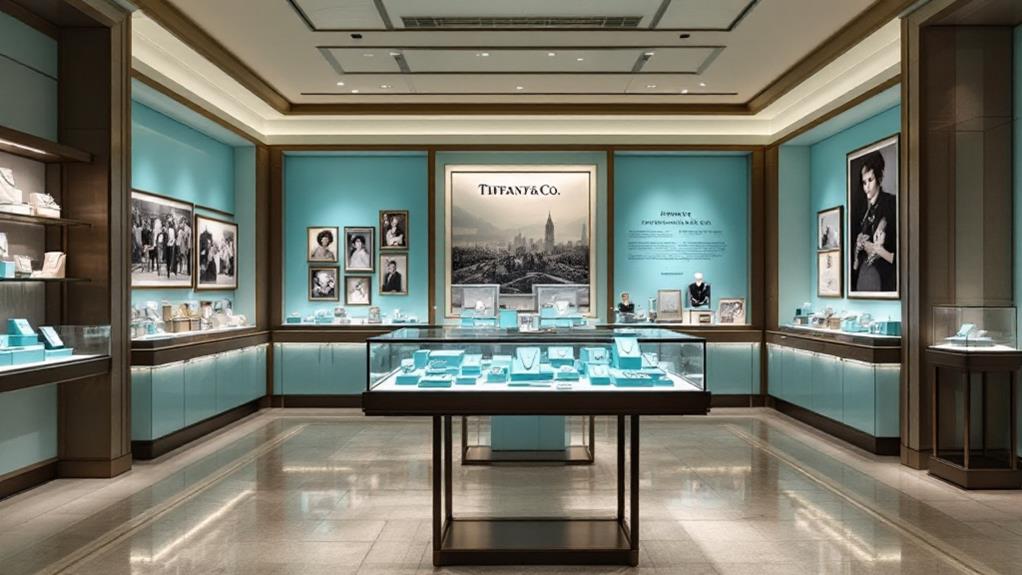
While Tiffany & Co.'s commitment to philanthropy shines, their legacy of excellence in luxury jewelry is similarly remarkable. You might be surprised to learn about the company's many significant milestones and achievements. It all began in 1867, when Tiffany & Co. won the grand prize for silver craftsmanship at the World Fair in Paris. This accolade firmly established their reputation for design and quality. Fast forward to 1902, when Louis Comfort Tiffany became the official design director, steering the company into the Art Nouveau movement and enhancing its creative direction.
Throughout its history, Tiffany & Co. has adeptly navigated economic challenges. During the 1990-1991 recession, the brand smartly pivoted to market affordable luxury items, ensuring they remained a household name. This adaptability not only preserved their brand presence but also broadened their customer base.
Key achievements include:
- Winning the grand prize for silver craftsmanship in 1867
- Louis Comfort Tiffany becoming design director in 1902
- Embracing affordable luxury during the 1990-1991 recession
- The LVMH acquisition in 2020 for $16.2 billion
In 2022, the iconic Tiffany brand was valued at $6.55 billion, with over 300 outlets worldwide continuing to showcase its timeless appeal.
Tiffany's Role in Popular Culture
In the domain of popular culture, few brands have achieved the iconic status of Tiffany & Co., famously immortalized by the 1961 film "Breakfast at Tiffany's" starring Audrey Hepburn. This film didn't just put a spotlight on Tiffany's as a luxury brand; it embedded the Tiffany Blue Box into the cultural consciousness as a symbol of elegance and sophistication. Audrey Hepburn's portrayal of Holly Golightly, with her timeless style, raised the brand to a new level of allure, capturing the imagination of audiences worldwide.
The color Tiffany blue, trademarked in 1998, is now synonymous with luxury and instantly recognizable in a range of media and branding efforts. You've probably seen it in everything from high-profile collaborations to magazine spreads. Tiffany & Co. has maintained its presence in contemporary pop culture, teaming up with icons like Beyoncé and Jay-Z, who celebrate Tiffany's storied elements in their campaigns. The brand's role as a cultural icon extends to its involvement in prestigious events, crafting trophies for the Super Bowl and World Series. In doing so, Tiffany & Co. solidifies its legacy as a timeless guide of luxury and cultural significance.
Acquisition by LVMH
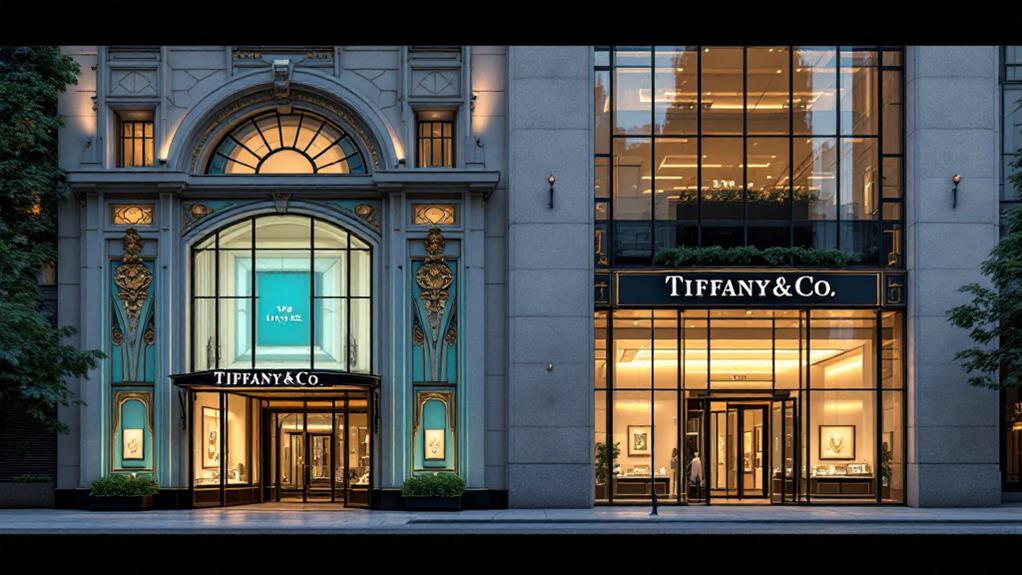
Tiffany & Co.'s status as a cultural icon continues to evolve through its acquisition by LVMH, completed in December 2020. This monumental deal, finalized for approximately $15.8 billion in January 2021, stands as one of the largest luxury acquisitions in history. By bringing Tiffany & Co. under its expansive umbrella, LVMH aims to bolster the brand's global footprint and amplify its presence, particularly in Asian markets. You're witnessing a strategic move that reinforces Tiffany's position as a leading luxury jewelry brand through significant investment in product offerings and groundbreaking marketing strategies.
The acquisition has already sparked a fresh wave of excitement and cultural relevance, marked by high-profile campaigns:
- Celebrity Endorsements: Beyoncé and Jay-Z featured prominently, highlighting Tiffany's enduring cultural impact.
- Market Expansion: Focus on growth, especially in Asia, aligns with LVMH's global aspirations.
- Product Advancement: Increased investment allows for creative and diverse product lines.
- Strengthened Brand Identity: Reaffirming Tiffany's iconic status in luxury jewelry.
With LVMH's expertise, Tiffany & Co. is poised to captivate a broader audience. As you follow Tiffany's path, you'll see how this acquisition shapes the brand's future in the luxury market, ensuring its legacy endures.
Legacy and Global Impact
Amid its storied history, Tiffany & Co. stands as a guiding light of luxury and elegance, influencing global jewelry standards with its groundbreaking designs. The iconic Tiffany Blue Box is instantly recognizable, symbolizing sophistication and exclusivity that every luxury jewelry aficionado cherishes. This distinctive packaging enhances your entire experience, from the moment you clasp your hands around the box to the revelation of the exquisite piece inside.
Charles Lewis Tiffany, the visionary founder, pioneered gemstone exploration, setting a foundation upon which the brand's rich legacy is built. His dedication to sourcing rare gemstones continues to define Tiffany's extraordinary offerings, ensuring that each piece tells a story of exploration and elegance. The revolutionary Tiffany Setting, introduced in 1886, transformed engagement rings, forever influencing the way you view luxury jewelry.
Beyond its dazzling creations, Tiffany & Co. demonstrates a profound commitment to philanthropy. Since 2000, the company has allocated approximately $20 million towards marine life and coral conservation, illustrating its dedication to social responsibility. Tiffany & Co.'s legacy is a reflection not only of its influential designs but also of its enduring impact on both the jewelry world and global conservation efforts.



